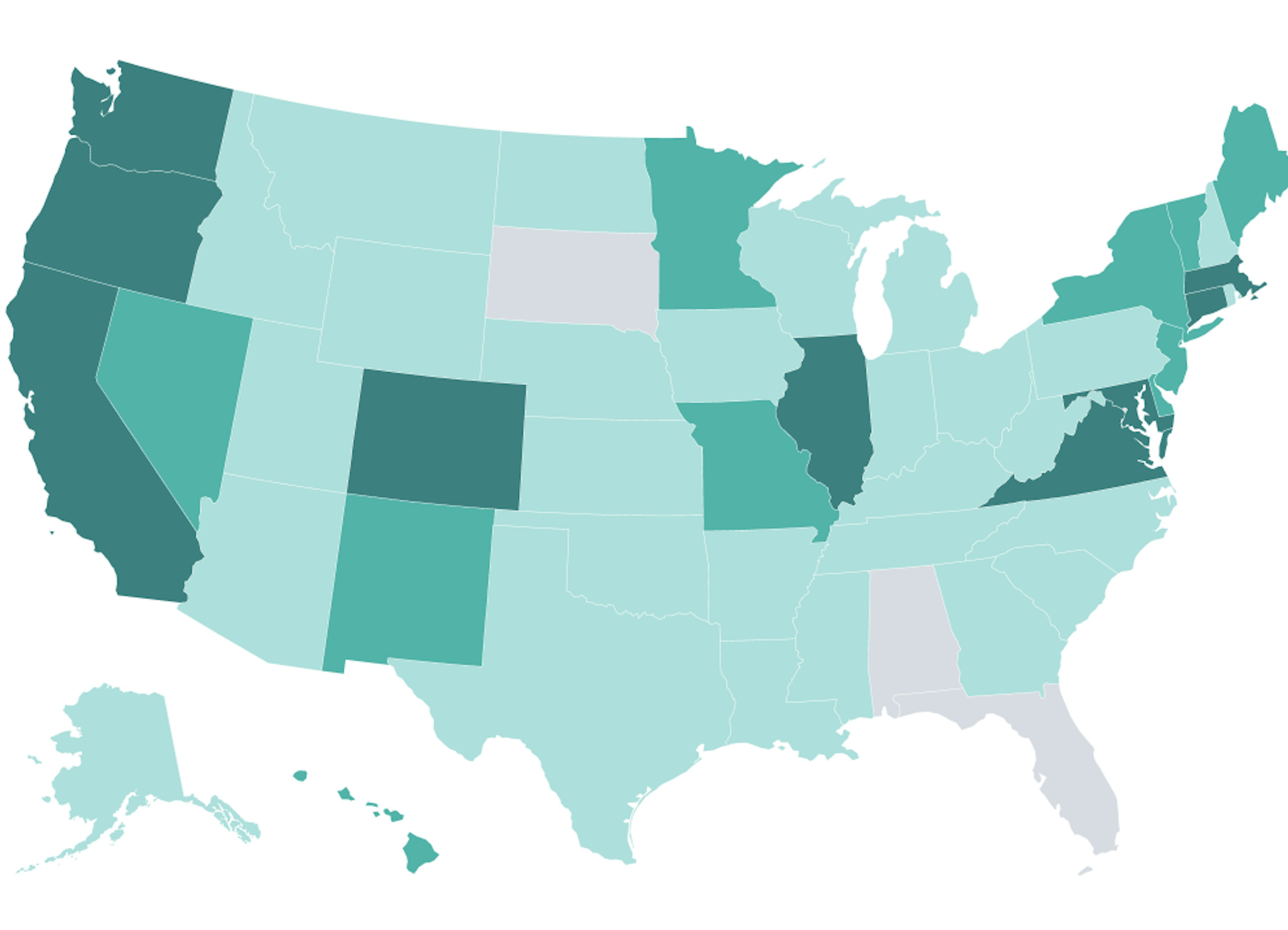About one-fourth of all U.S. adults have no retirement savings. At the same time, only 40% of working Americans are confident their retirement planning is on track, according to 2022 research from the Federal Reserve. To respond to America’s retirement savings crisis and help workers prepare for those later years, many states have created retirement programs for small businesses to offer their employees.
Since 2012, 46 states have implemented, studied, or considered legislation for state-run retirement programs. So far, six states have plans currently in operation, several with deadlines that have passed, while others have deadlines on the horizon.
Start a 401(k) with Human Interest
A Human Interest 401(k) plan can connect directly with your favorite payroll provider and has zero transaction fees.*
Still, U.S. workers are wondering if these state-run plans work. Let’s review the state of state-mandated retirement programs so far.
How do state-mandated retirement plans work?
To understand if state retirement programs work, we’ll first explain how they operate. Most of these state-provided options are Roth IRAs (note: Massachusetts offers a state-sponsored multiple-employer plan, or MEP, while Washington offers a voluntary marketplace that allows employers to search for plans).
Accordingly, IRAs have a different set of considerations to compare against a 401(k):
401(k)s can be both pre-tax and post-tax, while Roth IRAs are only post-tax.
401(k)s have a higher annual deferral contribution limit than Roth IRAs.
401(k)s do not have an Adjusted Gross Income limitation for participation, unlike Roth IRAs.
Here’s a quick breakdown of the models some states are deploying:
| Type of plan | States using this model | Compared to a 401(k) |
|---|---|---|
| Roth IRA | CA, IL, NY, OR | Lower annual contribution limit, contribution restrictions based on income. |
| Multiple Employer Plan (MEP) | MA | Less control over plan design, higher potential for abuse. |
| Marketplace | WA | Doesn’t directly offer retirement plans or list your options (or their pros and cons). |
Note: Some states are making enrolling optional, not mandatory. In other words, you have to enroll in a plan, not their plan.
For more information, read our blog: IRA vs. Roth IRA vs. 401(k): What’s the difference?
Which states are rolling out plans?
As of October 2022, 16 states and two cities have either passed laws or have pending legislation that outlines new programs for private-sector workers. Of that number, six states have active laws.
Let’s review the inner workings of three state programs: Oregon, Illinois, and California.
OregonSaves: The pioneer
With more than three years in operation, not only does OregonSaves appear to meet the expectations of state legislators and constituents, but we’re also starting to get some data on its performance. According to the Oregon Retirement Savings Board, 17,121 employers had enrolled in the plan, and 112,652 employees had funded accounts, with plan assets totaling more than $156 million, as of August 31, 2022.
A National Bureau of Economic Research study from February 2021 analyzed participation in OregonSaves from August 2018 through April 2020. Over the study period, some of the following trends appeared:
More than 67,700 employees accumulated over $51 million through April 2020.
The average account balance was $754, while the average monthly account-level inflow was $117.
Participation rate was 62.4% was “significantly below” levels in “firm-sponsored 401(k) plans,” which was in keeping with the study’s finding that by requiring employers of any size not to offer a retirement plan to participate, OregonSaves targeted more employers in industries with lower wages and higher turnover.
Of the employees who opted out, 30.3% stated they “can’t afford to save,” again, in keeping with the lower wages of eligible workers.
Younger employees were the most likely to opt out.
Opt-out rates were higher when unemployment rates were higher.
Employees active 18 months after their initial contribution have an average account balance of $1,132 (including account balances of zero) versus $370 for those classified as inactive.
The NBER study found that OregonSaves participation is either 34.3% or 64.2%, depending on which metric you use, leading the study authors to conclude that the program has meaningfully increased employee savings by reducing the need for employees to find their own retirement plan. A 2019 study from the Center for Retirement Research at Boston College found similar participation rates for OregonSaves to be between 48% to 67% (although the study claimed the exact speed was uncertain due to data limitations).
The overall takeaway from both studies may be that OregonSaves participants saved at a greater rate than employees with no retirement options through their employer, as measured by national IRA participation rates before the implementation of Oregon’s program. However, while the authors of this 2019 study stated that a majority of eligible employees participated, it was still too early to determine if these accounts were being used for retirement savings—or the lasting impacts the program is having on household finances.
Illinois Secure Choice: The cautious planner
Illinois Secure Choice is a Roth IRA program that will eventually be rolled out to all Illinois businesses of various sizes (employers with 5-15 employees are slated to have registration deadlines of November 1, 2023). While the Illinois-run savings program was slated to start earlier than OregonSaves, a measure was later enacted that delayed enrollment of Illinois workers until November 1, 2018.
Like many administrators of state-run plans around the country, the Illinois Treasury opted to delay program implementation until the initial results from OregonSaves were available. The main reason is that the Illinois Secure Choice Board estimated that up to 2.5 million workers in Illinois could benefit from the savings program.
The extra planning from the Illinois Secure Choice Board appears to have paid off in terms of lower cost and access to initial investment options. The plan charges workers an annual fee of approximately 0.75%of assets per year ($0.75 for every $100 saved) to cover the program's administration and the operating expenses charged by the underlying investment funds in which the program’s portfolios are invested.
In comparison, the annual fee from OregonSaves is about 0.25% of assets per year ($0.25 for every $100 saved). Employers pay no fees for either program. Illinois savers have access to a range of target-date funds, a bond fund, an equity index fund, and a pair of money market accounts.
As of September 2022, Illinois Secure Choice had:
7,486 registered employers
109,346 funded accounts
Almost $84 million in total assets
An average monthly account contribution of $144.29
More than $25 million in total withdrawals
Average funded account balance of $767.99
An effective opt-out rate of 31.92%
It’s a bit early to tell a straightforward story about the data coming out of Illinois, but the Human Interest team will keep an eye on future updates. In the meantime, you can check out our related article for a deeper dive into Illinois Secure Choice.
CalSavers: The Litmus Test
Potentially covering an estimated 300,000 businesses and up to 7.5 million workers, CalSavers is a crucial indicator of whether or not state-mandated retirement programs can work. CalSavers first became publicly available in July 2019.
Deadlines to register businesses with more than five employees have already passed, with the most recent deadline on June 30, 2022 (affecting employers with more than five employees). Employers with at least one employee, but fewer than five, will see legislation staggered out over time (the deadline is currently slated for December 31, 2025) but can register at any time.
So, is CalSavers working for California businesses and their employees? Data from August 2022 indicates steady growth for CalSavers. Employer registrations increased from 43,498 in April 2022 to 109,245 in September 2022. And as of September 2022, more than 360,000 funded accounts and more than $270 million in total assets were being managed. While this may not tell the whole story of CalSavers’ performance, there are a couple of potential red flags in the published data:
The average funded account balance dropped nearly $100 in the last three months, from $854 in July 2022 to $756 in September 2022.
CalSavers had a 37.41% opt-out rate as of September 30, 2022.
More than $53 million total has been withdrawn from accounts.
The Human Interest team will keep an eye on future report releases from the California Secure Choice Retirement Savings Investment Board.
Other states & their plans
Currently, state legislatures in Connecticut, Maryland, Massachusetts, New Jersey, New York, and Vermont (and several other states) are evaluating their own versions of retirement savings programs. While most of the state authorities have taken cues from California, Illinois, and Oregon, it’s important to point out variations in approach.
Washington borrowed a play from the implementation of the Affordable Care Act (ACA) back in 2013 and offers an online marketplace with low-cost retirement savings plans verified by state officials. Nothing is mandatory with the marketplace, which allows for easy search and links to various providers’ sites so that Washingtonians can identify the best option for their savings needs and goals.
Massachusetts and Vermont have chosen to participate in state-wide multiple-employer retirement plans (MEPs). A MEP allows several private-sector companies to provide access to the same payroll deduction retirement savings plan so long as specific criteria for eligibility are met.
The program operates under the same federal laws and regulations as other ERISA (Employee Retirement Income Security Act) retirement savings plans regarding contribution limits and IRA distribution rules. Vermont’s plan is voluntary and available to workers at businesses with 50 or fewer employees with no other retirement plan. Washington’s plan is different because it is intended for nonprofit organizations with 20 or fewer employees, though it is not mandatory.
Takeaway: The future is key
The reality is that it is still too early to determine whether state-mandated retirement programs work. Since becoming available to all eligible workers on June 30, 2022, participation rates of CalSavers, for example, have increased. However, we’re unable to deduce whether this indicates success in the program as a whole.
As the saying goes, saving for retirement is often a marathon, not a sprint. The same may be true of these programs. State-run retirement programs need more time to show their actual performance—while other programs are still yet to go live.
If you’re a small business owner and want to provide your employees with a workplace retirement savings plan, you don’t have to wait until your state creates one. Consider Human Interest in your search and reach out with any questions about 401(k) plans.
Start a 401(k) with Human Interest
A Human Interest 401(k) plan can connect directly with your favorite payroll provider and has zero transaction fees.*
* Applies to all transaction types. For non-rollover distributions, shipping and handling fees may apply to requests for check issuance and delivery.
Article By
The Human Interest TeamWe believe that everyone deserves access to a secure financial future, which is why we make it easy to provide a 401(k) to your employees. Human Interest offers a low-cost 401(k) with automated administration, built-in investment education, and integration with leading payroll providers.


